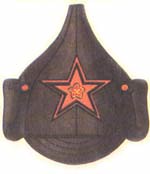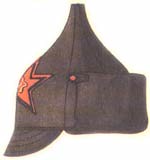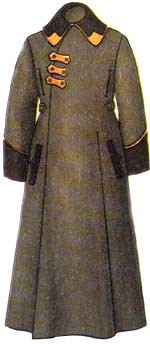10:57 AM
Assistance with a RCW Infantry Uniform request
Mister Nizz

"IT figures 20mm greatcoats with budenovka hat"
Help! I'm expecting a bunch of infantry from Lancashire games at some point in the next couple weeks. I would like to have them painted (yes, gasp! With a painting service!). I'm trying to figure out what color the budenovka and greatcoat were. The Osperey plate (top) would indicate it was the standard Russian greenish khaki. The Gauntlet
international publication (below) would indicate that the coast is almost tan (as well as the hat). Is the blue piping accurate? Or is this a dismounted Konarmiya cavalryman? The piping on this surviving budenovka would indicate RED piping and a red star. Which is right?


Assuming that the two figures above represent variations of a cavalryman, what was the correct color and piping for infantry? Many thanks in advance for your help in getting this right.
Note: In both of the top plates, the figure I'm asking about is on the right hand side.
You may respond here as a comment, via email (remove the allcaps), or on TMP.
Thanks again.
UPDATE
From Keith Laycock, over on CONSIMWORLD, where I also posted a version of this message:
Keith Laycock - Jun 26, 2006 12:47 pm (#7385 Total: 7385)
The figure on the Osprey plate is indeed a cavalry officer, specifically a deputy regimental commander in 1922.
The Red cavalry used cornflower blue as its arm-of-service color; the infantry used crimson piped with black, and the artillery and engineers used black piped with scarlet. Note that these arm-of-service colors weren't officially adopted until January 1919.
The new-style greatcoat (or "kaftan") with prominent colored tabs shown in both cover illustrations was originally made of khaki cloth, as was the budenovka. The kaftan was introduced in April 1919, but was initially in very short supply and wasn't widely seen until a year later. Therefore, in October 1919, troops were instructed to "requisition" overcoats from civilians in preparation for the coming winter. In January 1922, new uniform regulations were issued, under which both the greatcoat and the budenovka became dark gray (like the example in your photograph).
Obviously, none of these specified changes in clothing could be implemented instantaneously, especially during the main period of fighting in 1919-20, so older items remained in use long after they were supposed to be replaced.
So, we can assume that an "Infantry figure with overcoat" at the time of the Russo-Polish conflict, might have a faded khaki overcoat with arm-of-service touches (cuffs, collar) being "scarlet piped with black". Seems to me if I get it painted that way it will work right up until the mid-1920s.
Not that it's definitive or anything, but the CARD illustration for RED ACTIONS! would indicate this paint scheme. Click to enlarge:

Allen Curtis from TMP pointed out the Russian Army museum uniform examples, but these appear to be from a later, more standardized era. They DO show the correct placement of the collar tabs and cuff markings, as well as the highly distinctive coat button pattern on the chest. The hat isn't quite this dark in the time period I'm trying to paint in, but it looks almost exactly like this hat in other respects.



The coat is dark and the tabs are yellowing with age, but this is the standard cut (with the yellow parts red and some contrasting color on the cuffs).